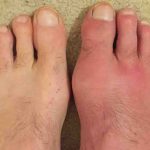Nonsurgical Treatment

Exercise: Plantar fasciitis treatment starts with first-line strategies. The treatment strategies can commence at home. They include stretching exercises meant to stretch out calf muscles to ease pain and boost recovery. It’s also important to avoid walking barefoot during the initial stages of treatment. Walking barefoot puts undue stress and strain on your plantar fascia.
Ice: Another notable nonsurgical treatment involves the use of ice. Plantar fasciitis causes like inflammation can be reduced by placing ice on your heel for a few minutes (20 minutes), several times daily. You should place a thin towel between your heel and ice or use an ice pack. Ice shouldn’t be placed directly on the heel as this may cause discomfort and prolonged numbness.
Limiting movement: Limiting your activity is also a recommended remedy. You should allow your heel as much resting time as possible. You should consider cutting down on all extended physical activities when recovering from heel pain.
Shoe modifications: Wearing modified shoes which offer special support to the arches and heel reduces the stress and pressure exerted on your plantar fascia significantly.

Medication: Prescription medicine can also be used to treat plantar fasciitis. NSAIDs (oral non-steroidal anti-inflammatory drugs) like ibuprofen are usually prescribed to reduce inflammation and pain. If the pain persists for weeks despite being on medication, it is advisable to visit your food and ankle orthopedic surgeon again. You may require more treatment approaches such as taping, padding and strapping. Padding involves placing soft pads in your shoes to reduce the impact of walking. Strapping and tapping help to support the foot reducing stress and strain on the fascia.
Orthotic devices: In cases where shoe modifications don’t work, orthotic devices can be fitted in your shoes to help you correct underlying structural abnormalities responsible for causing plantar fasciitis.
Injection therapy: Corticosteroid injections can be used for relieving pain and reducing inflammation. This treatment remedy is recommendable when oral non-steroidal anti-inflammatory medicines don’t work effectively.
Walking cast: In some cases, you may need a cast to keep your foot immobile. A cast can be used to allow your foot enough time to heal. Removable walking casts are highly recommended because they can be removed with ease.
Night splint: If your surgeon recommends that you keep your plantar fascia extended while sleeping, you will need to wear a night splint to keep your plantar fascia extended throughout the night providing relief from morning pain reported by most patients.
Physical therapy: Exercising and physical therapy can provide some much-needed relief to patients suffering from plantar fasciitis.
More from Things Health
-
Symptoms of Gout
Gout is a form of inflammatory arthritis characterized by recurrent attacks of a red, tender, hot, and swollen joint. Pain typically comes on rapidly in…
-
Symptoms Of Epilepsy
Epilepsy a neurological disorder marked by sudden recurrent episodes of sensory disturbance, loss of consciousness, or convulsions, associated with abnormal electrical activity in the brain.…
-
Symptoms Of Ovarian Cancer
Ovarian cancer is often referred to as a quiet disease as it usually isn't discovered until it is in the advanced phases. In nearly all…
-
Symptoms of Adult ADHD
It is not easy for a doctor to diagnose adult attention deficit hyperactivity disorder. An adult will understand the signals of ADHD in himself or…
-
Symptoms Of An Ulcer
A peptic ulcer is an open sore in the top digestion tract. Both primary kinds of peptic ulcers, a gastric ulcer, which forms in the…

















